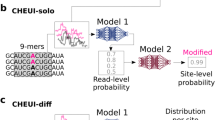Abstract
Correlation between mRNA and protein expression is typically modest due to substantial posttranscriptional regulation. Using large-scale transcriptomic and proteomic data of the yeast Saccharomyces cerevisiae, we quantitatively examined the effects of several posttranscriptional biological properties on the correlation between mRNA and protein expression levels (mRNA–protein correlation) on a genomewide scale. The two classes of properties investigated are (1) stability of mRNA and protein molecules and (2) biological properties related to translational process, such as codon usage and amino acid usage, and experimental data of ribosome density and occupancy. The multiple regression analysis showed that while mRNA half-life and translation initiation efficiency (estimated as mRNA secondary structure in the 5′-UTR) do not appear to have remarkable contributions to the variations in the mRNA–protein correlation, protein half-life descriptor (PHD) is identified as the most important property affecting mRNA–protein correlation (contributing to 16.87% of the total variation in mRNA–protein correlation), suggesting protein degradation significantly affects mRNA–protein correlation. Codon usage and amino acid composition contribute to 8.89% and 7.60% of the total variation, respectively, which is consistent with several previous studies in bacteria (such as Escherichia coli, Haemophilus influenzae, and Desulfovibrio vulgaris), suggesting that mRNA–protein correlation is affected the most by elongation during protein translation. Taken together, all posttranscriptional biological properties contributed to 33.15% of the total variation of mRNA–protein correlation.
Similar content being viewed by others
References
Akashi H (2003) Translational selection and yeast proteome evolution. Genetics 164:1291–1303
Belle A, Tanay A, Bitincka L, Shamir R, O’Shea EK (2006) Quantification of protein half-lives in the budding yeast proteome. Proc Natl Acad Sci USA 103:13,004–13,009
Beyer A, Hollunder J, Nasheuer HP, Wilhelm T (2004) Post-transcriptional expression regulation in the yeast Saccharomyces cerevisiae on a genomic scale. Mol Cell Proteomics 3:1083–1092
Brockmann R, Beyer A, Heinisch JJ, Wilhelm T (2007) Posttranscriptional expression regulation: what determines translation rates? PLoS Comput Biol 3:e57
Chhabra SR, He Q, Huang KH et al (2006) Global analysis of heat shock response in Desulfovibrio vulgaris Hildenborough. J Bacteriol 188:1817–1828
Futcher B, Latter GI, Monardo P, McLaughlin CS, Garrels JI (1999) A sampling of the yeast proteome. Mol Cell Biol 19:7357–7368
Ghaemmaghami S, Huh WK, Bower K et al (2003) Global analysis of protein expression in yeast. Nature 425:737–741
Greenbaum D, Colangelo C, Williams K, Gerstein M (2003) Comparing protein abundance and mRNA expression levels on a genomic scale. Genome Biol 4:117.1–117.8
Gygi SP, Rochon Y, Franza BR, Aebersold R (1999) Correlation between protein and mRNA abundance in yeast. Mol Cell Biol 19:1720–1730
Ideker T, Thorsson V, Ranish JA et al (2001) Integrated genomic and proteomic analyses of a systematically perturbed metabolic network. Science 292:929–934
Lange R, Hengge-Aronis R (1994) The cellular concentration of the S subunit of RNA polymerase in Escherichia coli is controlled at the levels of transcription, translation, and protein stability. Genes Dev 8:1600–1612
Lithwick G, Margalit H (2003) Hierarchy of sequence-dependent features associated with prokaryotic translation. Genome Res 13:2665–2673
MacKay VL, Li X, Flory MR et al (2004) Gene expression in yeast responding to mating pheromone: analysis by high-resolution translation state analysis and quantitative proteomics. Mol Cell Proteomics 3:478–489
Nie L, Wu G, Zhang W (2006) Correlation between mRNA and protein abundance in Desulfovibrio vulgaris: a multiple regression to identify sources of variations. Biochem Biophys Res Commun 339:603–610
Nie L, Wu G, Zhang W (2006) Correlation of mRNA expression and protein abundance affected by multiple sequence features related to translational efficiency in Desulfovibrio vulgaris: a quantitative analysis. Genetics 174:2229–2243
Ott RY, Longnecker M (2001) An introduction to statistical methods and data analysis. Duxbury Thompson Learning, Pacific Grove, CA, pp 646–650
Preiss T, Baron-Benhamou J, Ansorge W, Hentze MW (2003) Homodirectional changes in transcriptome composition and mRNA translation induced by rapamycin and heat shock. Nat Struct Biol 10:1039–1047
Ringner M, Krogh M (2005) Folding free energies of 5′-UTRs impact post-transcriptional regulation on a genomic scale in yeast. PLoS Comput Biol 1:e72
Sharp PM, Li WH (1987) The codon adaptation index: a measure of directional synonymous codon usage bias, and its potential applications. Nucleic Acids Res 15:1281–1295
Wang Y, Liu CL, Storey JD, Tibshirani RJ, Herschlag D, Brown PO (2002) Precision and functional specificity in mRNA decay. Proc Natl Acad Sci USA 99:5860–5865
Washburn MP, Koller A, Oshiro G et al (2003) Protein pathway and complex clustering of correlated mRNA and protein expression analyses in Saccharomyces cerevisiae. Proc Natl Acad Sci USA 100:3107–3112
Wu G, Nie L, Freeland SJ (2007) The effects of differential gene expression on coding sequence features: analysis by one-way ANOVA. Biochem Biophys Res Commun 358:1108–1113
Author information
Authors and Affiliations
Corresponding author
Rights and permissions
About this article
Cite this article
Wu, G., Nie, L. & Zhang, W. Integrative Analyses of Posttranscriptional Regulation in the Yeast Saccharomyces cerevisiae Using Transcriptomic and Proteomic Data. Curr Microbiol 57, 18–22 (2008). https://doi.org/10.1007/s00284-008-9145-5
Received:
Accepted:
Published:
Issue Date:
DOI: https://doi.org/10.1007/s00284-008-9145-5




